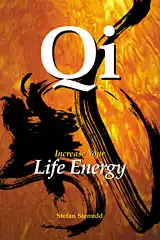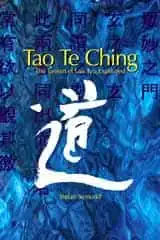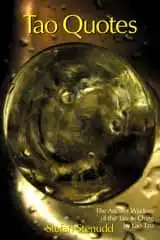|
Tao Te Ching
THE TAOISM OF LAO TZU
|
Tao Te Ching
|
The Book
The Taoism of Lao Tzu Explained. The great Taoist philosophy classic by Lao Tzu translated, and each of the 81 chapters extensively commented. Click the image to see the book at Amazon (paid link). |
Preface
My first meeting with the Tao Te Ching was in my late teens. It was Toshikazu Ichimura, my Japanese teacher of the peaceful martial art aikido, who gave me a copy of it – the Gia-Fu Feng and Jane English version with beautiful calligraphy, which is still in print. He thought that my impatiently inquisitive mind would benefit from studying it.Already by reading the first chapter, which compares desire and the freedom from desire without seeming judgmental, I was hooked. That appeals to a teenager.
The book remained with me, far beyond my teen years. It spoke of so many other things that I found relevant. Contrary to most reading experiences of my youth, I found Lao Tzu's work to increase its relevance, as if written in a future that we still have not reached. That alone is an enigma making it impossible to let the book gather dust in the shelf. It contains many others.
Tao Te Ching, which is the major source of Taoism, has a clouded origin. It was composed no earlier than the 6th and no later than the 4th century BC. According to legend, its writer was Lao Tzu, a high official of the Chinese empire, who left his work and his country in dismay, fed up with the charade of government.
He is said to have departed riding on a water buffalo. A border guard, impressed by his wisdom, pleaded him to write down his thoughts before leaving China. So he did. Then he crossed the border, never to be seen again.
His text is around five thousand words long, divided into two parts. One of them begins with the word Tao, the Way, the other with the word Te, virtue. The Tao Te Ching, the Book on the Way and Virtue, is a text as difficult to interpret as its origin is to ascertain. It speaks with simple directness, but conveys ideas so elusive that they have been discussed for over two thousand years, without any consensus reached as to their meaning.
Although clear about presenting a worldview and arguing for it, the book is written with the elegance and artistry that makes it most appropriate to call it a poem. Also, most of it is rhymed. That's not very difficult with Chinese rules for rhyme, but it still indicates that the author intended more than to pursue a line of reasoning.
Probably, the subtleties included were only possible to put into words with the added sophistication of poetry. What was to be said needed an artistic approach, just like some complex truths about the conditions of life need fiction to be pointed out.
To be understood at all, the text needs to be contemplated and interpreted by several minds. This has indeed been done, through the centuries, and that process is not at all slowing down.
Tao Te Ching has had countless Chinese commentaries through its circa 2,500 years of existence. The text reached the West rather late, but we've more than made up for that by an accelerating number of Western translations in the last hundred years. They keep coming.
That's necessary. The text is far too vague and unclear to be trusted to just one translation. There must be several perspectives in which to see it and several shapes in which to form its wordings in English and other languages.
No doubt, although the text has been kept faithfully intact through all this time, each generation needs its renewed interpretations in order to approach it and grasp its subtle meaning.
That's true for any classic. In a constantly changing world, it's necessary to reinterpret the classics in order to have a chance of grasping them. That way, we may even succeed to reveal new things about them, and come closer to a definitive understanding of them. Even if we don't, it's by reexamination that we keep them alive and carry them with us into the future. The words of Lao Tzu definitely belong to those that deserve our continued attention and preservation.
So, here is my version of the Tao Te Ching.
Almost twenty years ago, I made a Swedish translation of Lao Tzu's text, the first edition of which was published in 1992. Actually, the project started with another goal in mind.
In the 1980s, I was writing a novel and got the idea to begin each chapter with a quote from the Tao Te Ching. That would fit my story in an intriguing way. But the few existing Swedish versions of the Chinese classic didn't appeal to me as much as the English versions I had come across. After some struggle, I came to the conclusion that I needed to make my own translations of the quotes I wanted to use.
The job was mesmerizing, so I found myself translating the whole book. I was still in doubt about it, until a prominent Chinese poet, Li Li, who lives in Sweden, agreed to proof read. He approved of my version, with some kind words about it that made me confident enough to have it published. My novel was published later the same year.
Since then, I have reexamined and reworked my Swedish version of the Tao Te Ching in several editions. It has become an obsession.
For this English edition, though, I started all over. I wanted to avoid following old trains of thought and any preconceptions. The translation into another language needed a fresh approach.
Sure enough, it made me discover new things about the text and coming to new conclusions about its content. So, for me it was again a wonderful journey. I hope the reader will share some of my delight.
In this version, I have returned to a very old tradition in dealing with the classics, practiced in the East as well as in the West. I let each chapter be followed by my comments about it. That way, the reader will have me as a close companion all through the Tao Te Ching. Those who prefer to do the voyage through Lao Tzu's words all by themselves can simply skip my comments and go directly from chapter to chapter of the translated text.
As for my comments, I mainly try to explain what I believe Lao Tzu to be pointing out in each chapter. I frequently use modern phenomena as references, so that it's obvious how much Lao Tzu still has to teach us. I have no doubt of it.
Where needed, I also explain some circumstances of the Chinese context in which Lao Tzu was writing. But most of his text deals with matters that are just as true now, in the Western world, as they were in China some 2,500 years ago.
As for my translation of the Tao Te Ching chapters, my main effort has been to make the text direct, to the point, without additional poetic clouding or any attempt of decorating it in a manner common for sacred texts. That's how I perceive the original.
Lao Tzu spoke with amazing simplicity and clarity, using almost no decorations or other intricacies in his language. Although the meaning behind them is often vague, maybe even cryptic, his words are easy to understand.
That's what I have tried to accomplish in this translation. Lao Tzu's message is far too important for his words to be covered in archaic artistry that was not present to begin with.
Like many other supreme works of literature, his words remain here and now, no matter how many years have passed since they were written. In translating them, we should not try to cover them in dust, as a futile method of dating them, but brush them off and present them in the purity and relevance they seem never to lose.
Tao Te Ching is one of those books that forever stay contemporary.
Stefan Senudd
February, 2011
Tao Te Ching Explained
Preface
Introduction
Literature
translated and explained by Stefan Stenudd.
1 |
2 |
3 |
4 |
5 |
6 |
7 |
8 |
9 |
10 |
11 |
12 |
13 |
14 |
15 |
16 |
17 |
18 |
19 |
20 |
21 |
22 |
23 |
24 |
25 |
26 |
27 |
28 |
29 |
30 |
31 |
32 |
33 |
34 |
35 |
36 |
37 |
38 |
39 |
40 |
41 |
42 |
43 |
44 |
45 |
46 |
47 |
48 |
49 |
50 |
51 |
52 |
53 |
54 |
55 |
56 |
57 |
58 |
59 |
60 |
61 |
62 |
63 |
64 |
65 |
66 |
67 |
68 |
69 |
70 |
71 |
72 |
73 |
74 |
75 |
76 |
77 |
78 |
79 |
80 |
81 |
Tao Te Ching Explained
James Legge's Tao Te Ching
Aleister Crowley's Tao Te Ching
The 1st Chapter of Tao Te Ching in 76 Versions
Lao Tzu — Legendary Author of Tao Te Ching
My Taoism BooksClick the image to see the book at Amazon (paid link).
The Taoism of Lao Tzu Explained. The great Taoist philosophy classic by Lao Tzu translated, and each of the 81 chapters extensively commented. |
About Cookies
My Other Websites:
I Ching Online
The 64 hexagrams of the Chinese classic I Ching and what they mean in divination. Try it online for free.
Qi Energy Exercises
The ancient Chinese life energy qi (chi) explained, with simple instructions on how to exercise it.
Life Energy
The many ancient and modern life force beliefs all over the world explained and compared.
Taoismen på svenska
Other Books by Stefan Stenudd
Click the image to see the book at Amazon (paid link).
 Cosmos of the Ancients
Cosmos of the Ancients
The Greek philosophers and what they thought about cosmology, myth, and the gods.
 Qi — Increase Your Life Energy
Qi — Increase Your Life Energy
The life energy qi (also chi or ki) explained, with exercises on how to awaken, increase and use it.
 Aikido Principles
Aikido Principles
Basic concepts of the peaceful martial art. Aikido principles, philosophy, and fundamental ideas.
 Life Energy Encyclopedia
Life Energy Encyclopedia
Qi, prana, spirit, ruach, pneuma, and many other life forces around the world explained and compared.
 Archetypes of Mythology
Archetypes of Mythology
Jungian theories on myth and religion examined, from Carl G. Jung to Jordan B. Peterson.
 Stefan Stenudd
Stefan Stenudd
About me
I'm a Swedish author and aikido instructor. In addition to fiction, I've written books about Taoism and other East Asian traditions. I'm also an historian of ideas, researching ancient thought and mythology. Click the image to get to my personal website.Contact

 Tao Te Ching
Tao Te Ching Tao Quotes
Tao Quotes Fake Lao Tzu Quotes
Fake Lao Tzu Quotes